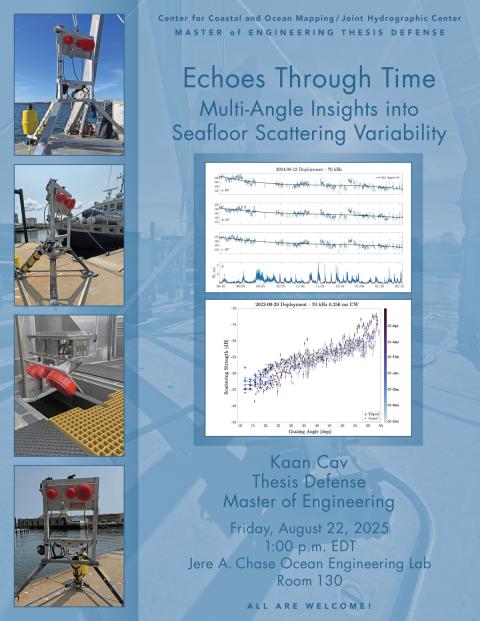Kaan Cav
Thesis Defense
Master of Engineering
Friday, August 22, 2025, 1:00pm
Chase 130
Abstract
Multi-angle measurements of high frequency seafloor acoustic scattering strength at the mouth of the Piscataqua River, Gulf of Maine Abstract: Active sonar systems are used for many remote sensing applications such as hydrography, seafloor characterization, and target detection. Previous work has focused on the dependence of seafloor scattering strength on sediment type, grazing angle, and frequency, however the seasonal variability of seafloor scattering strength has not been studied as extensively. Surface roughness is an important contributor to seafloor scattering strength. Environmental drivers that affect the surface roughness of the seabed such as storm driven near bed hydrodynamics and benthic activity are of particular interest. This research aims to quantify the dependence of seafloor scattering strength on environmental factors occurring on time scales of weeks, months and years. Data were acquired using a 2 m tall tripod sitting on the seabed in a shallow water, sandy site located at the mouth of the Piscataqua River (NH, USA). The tripod was equipped with three transducers with nominal frequencies of 70 kHz, 200 kHz, and 333 kHz; all of which collected measurements of seafloor scattering strength in the 8◦ − 22◦ grazing angle range. The tripod had a CTD collecting environmental measurements throughout the deployment. The datasets include data from 2022-23, 2023-24 and 2024-25. Data collected using ship-based split-beam transducers with nominal frequencies of 70 kHz, 120 kHz, 200 kHz, and 333 kHz on a multi-angle mount were conducted monthly throughout the winters as well. The ship-based measurements cover a larger range of grazing angles, spanning angles from 20◦ − 90◦. The research presented here restricts its scope to the 70 kHz pulsed continuous wave data. Scattering strength at fixed grazing angles was observed to vary seasonally by up to 10 dB, with decreases during periods of high storm activity and increases during calmer periods. Hydrodynamic forcing appears to influence these changes whilst biological activity may also be a cause of seafloor scattering strength variability, underscoring the importance of temporal context in interpreting acoustic measurements.
Bio
Kaan Cav received his undergraduate education from the University of New Hampshire; graduating with a B.A. in Physics and a minor in German. He is also fluent in Turkish. During his time as an undergraduate and following his graduation, he worked in the telecommunications industry where he mostly focused on fiber optics design and implementation in rural communities.
Currently, Kaan is pursuing an M.Eng. with a focus in acoustics. His interest in the ocean stems from his childhood when he spent the summers watching boats sail up and down the Bosphorus in Istanbul.

